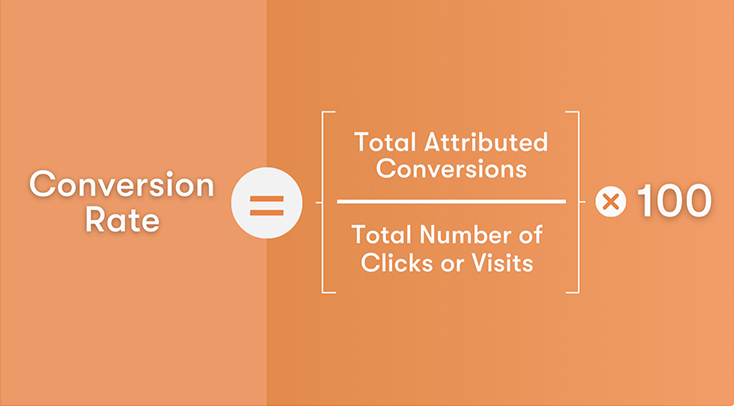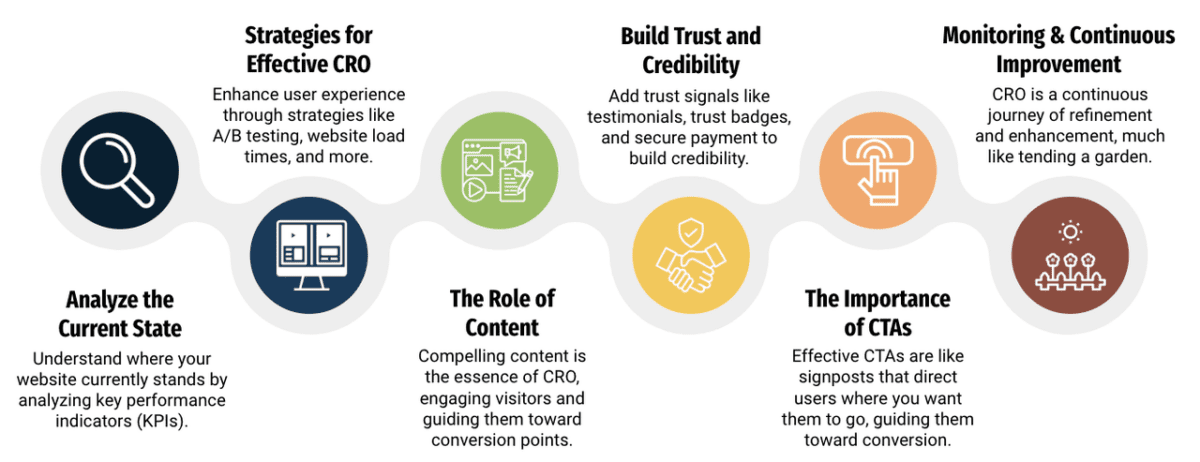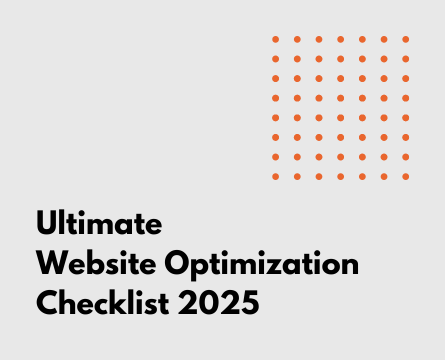What is Conversion Rate Optimization?
Conversion Rate Optimization (CRO) is the systematic process of improving the percentage of website visitors who take a desired action — whether that’s filling out a form, becoming customers, or otherwise. CRO involves understanding how users navigate your site, what actions they take, and what’s stopping them from completing your goals.
CRO is critical because it directly impacts the bottom line of your business. Increasing your conversion rate means getting more value from the traffic you already have, which can lead to more leads, sales, and overall business growth without necessarily increasing your marketing spend.
CRO works by identifying areas of improvement on your website or digital platforms through both qualitative and quantitative analysis. By running experiments (such as A/B tests) and applying changes based on data-driven insights, you can improve the efficiency of your website and optimize user behavior to achieve higher conversion rates.
Why is Conversion Rate Optimization Important?
Conversion Rate Optimization is a vital aspect of digital marketing for several reasons. Its importance can be summarized by the following benefits:
1. Maximizes the Value of Existing Traffic
Many businesses spend significant amounts of money driving traffic to their websites through advertising, social media, and content marketing. However, if that traffic doesn’t convert into customers, the investment may be wasted. CRO helps businesses extract maximum value from their existing traffic by ensuring that the user experience and messaging are optimized to convert visitors into leads or customers.
2. Reduces Customer Acquisition Costs
Acquiring new customers can be costly, but optimizing your site’s conversion rate enables you to lower your overall customer acquisition costs. Instead of constantly spending more on marketing campaigns to attract new visitors, CRO helps increase the percentage of visitors who convert, making your marketing efforts more efficient.
3. Increases Revenue
By improving your conversion rate, you directly increase your revenue. For example, if your website has a 3% conversion rate and you manage to increase that to 4%, you’ll see a 33% increase in sales without needing to increase traffic. This can have a significant impact on your business’s growth trajectory.
4. Improves User Experience
A key part of CRO is improving the user experience (UX) on your website. By analyzing how users interact with your site, you can identify pain points and bottlenecks that may be causing them to leave without converting. Improving these aspects of your site not only boosts conversions but also enhances overall user satisfaction.
5. Provides Insights into Customer Behavior
CRO involves detailed analysis of how visitors interact with your site. This can provide valuable insights into customer behavior, preferences, and pain points. Understanding this information can help you refine not only your website but also your overall marketing strategy.
Conversion Rate Metrics and How to Calculate Them
Now let’s continue with the key metrics that determine your site’s performance.

What is a Conversion Rate?
Your website’s conversion rate is the percentage of visitors who take a desired action on your site. This could include actions such as making a purchase, signing up for a newsletter, filling out a form, or clicking a call-to-action button.
The formula to calculate your conversion rate is:
Conversion Rate = ( Conversions / Total Visitors ) × 100
For example, if your website had 50 conversions and 1,000 visitors in a month, your conversion rate would be 5%.
What is a Good Conversion Rate?
A good conversion rate varies by industry, website type, and goals. For eCommerce, the average conversion rate is around 2-3%, but high-performing sites can reach rates of 5% or more. Lead generation sites may have conversion rates between 5-10%, depending on the value of the offering and the strength of the marketing funnel.
How to Calculate Your Conversion Rate
- Define Your Goal: First, decide what action counts as a conversion. This could be completing a purchase, signing up for a newsletter, downloading an eBook, etc.
- Track Your Traffic: Use analytics tools like Google Analytics to monitor the number of visitors to your website.
- Track Conversions: Identify the number of visitors who completed the desired action.
- Apply the Formula: Use the formula mentioned above to calculate your conversion rate.
I know it doesn’t sound too hard, but it’s always good to have a solid foundation.
CRO and SEO: A Powerful Combination
CRO and SEO often go hand in hand. While SEO focuses on driving traffic to your website, CRO ensures that the traffic you attract converts into customers or leads. When executed together, they can significantly amplify the effectiveness of your digital marketing efforts.
How CRO Complements SEO
CRO complements SEO by ensuring that the traffic generated through organic search is optimized for conversions. Simply driving traffic to your site is not enough; you need to ensure that visitors are engaged and taking action once they arrive. CRO focuses on optimizing landing pages, CTAs, and overall user experience, making it easier for visitors to convert.
Balancing SEO with User Experience
While SEO often involves optimizing content for keywords and search intent, CRO focuses on user behavior. One of the key challenges is balancing the need to include keywords for SEO with maintaining a smooth and engaging user experience. You should focus on creating content that satisfies both search engines and users by delivering high-quality, relevant information and intuitive design.
Using CRO to Maximize Organic Traffic Conversions
When a site is well-optimized for conversions, it makes better use of the traffic it receives from SEO efforts. For example, if you rank highly for a particular keyword but the page visitors land on isn’t optimized to convert, you could be missing out on valuable leads or sales. CRO can help turn that traffic into revenue by making sure the landing page resonates with visitors.
Where to Apply Conversion Rate Optimization
Effective CRO starts with identifying key areas of your website where improvements will have the biggest impact. Below are common areas to focus your CRO efforts:
1. Homepage
Your homepage is often the first point of contact between your brand and potential customers. It needs to convey a strong value proposition, offer clear navigation, and prompt users to take action. Consider placing a compelling call to action (CTA) above the fold, ensuring that users are encouraged to explore further or make a purchase.
2. Product Pages
Product pages need to provide potential buyers with enough information to make informed purchasing decisions. Focus on improving:
- Product Photography: High-quality images help users visualize products, increasing their confidence in making a purchase.
- Product Descriptions: Your product descriptions should highlight key features and benefits in a clear, concise, and persuasive manner.
- Brand Voice: Maintaining a consistent and engaging brand voice across your product pages helps build trust and resonate with your target audience. The less ChatGPT is the better 🙂
3. Blog Posts
Blog posts still play a role in driving organic traffic and generating leads. To optimize blog posts for conversion:
- Strategic CTAs: Place relevant calls to action within the content to encourage readers to subscribe, download resources, or make a purchase.
- Lead Generation Forms: Use lead forms at strategic points within your blog to capture information from interested readers.
4. Landing Pages
Landing pages are designed to convert visitors by focusing on a single goal. Key optimization tips for landing pages include:
- Information Hierarchy: Make sure the most important information (such as your value proposition and CTA) is at the top of the page.
- Iterative Testing: Continuously test and iterate on elements like headlines, copy, and CTAs to improve performance.
5. Checkout Process
Optimizing the checkout process is crucial for eCommerce businesses. Some strategies include:
- Cart Abandonment Solutions: Use tools like exit-intent popups or reminder emails to reduce the number of users who abandon their carts.
- Simplified User Experience: Ensure the checkout process is as straightforward and intuitive as possible, reducing friction for users.

Top 10 CRO Strategies to Increase Your Conversion Rate
There are numerous strategies you can employ to improve your website’s conversion rate. Here are 10 of the most effective:
1. Optimize Your Calls to Action (CTAs)
CTAs are one of the most critical elements on your website. To optimize them:
- Use actionable language that clearly states what the user should do.
- Make your CTA buttons stand out with contrasting colors.
- Place CTAs strategically throughout your site (e.g., at the end of blog posts, product pages, etc.).
2. Simplify Website Navigation
Complex or cluttered navigation can confuse users and prevent them from taking action. Ensure your site’s navigation is intuitive, with clear menus and easy access to important pages like product categories, contact information, and the shopping cart.
3. Run A/B Testing on Key Pages
A/B testing allows you to compare different versions of a webpage to see which one performs better. Test elements like:
- Headlines and copy
- Button placement and color
- Images and media
4. Leverage Social Proof
Displaying reviews, testimonials, and user-generated content helps build trust with potential customers. Social proof can reduce uncertainty and persuade visitors to convert.
5. Use Pop-Ups and Hello Bars
Strategically timed pop-ups can capture visitor attention and encourage them to take action, such as signing up for a newsletter or downloading a resource. However, make sure pop-ups are not intrusive and don’t negatively impact the user experience.
6. Improve Page Load Speeds
Slow websites lead to high bounce rates and lower conversions. Use tools like Google PageSpeed Insights to test your site’s performance and implement optimizations to speed up page load times.
7. Focus on Mobile Optimization
With an increasing number of users browsing on mobile devices, it’s critical to ensure your website is mobile-friendly. Optimize your design for smaller screens, and make sure buttons and CTAs are easy to tap on mobile devices.
8. Use Heatmaps to Understand User Behavior
Heatmapping tools allow you to see where users are clicking, scrolling, and spending the most time on your pages. Use this data to identify areas of improvement and optimize user pathways for conversions.
9. Implement Abandoned Cart Emails
For eCommerce sites, sending automated emails to users who have abandoned their carts can help recover lost sales. These emails should be timely and include a clear CTA to complete the purchase.
10. Personalize User Experience Based on Data
Personalization can greatly enhance conversion rates by showing users content that’s relevant to them based on their behavior and preferences. This could include personalized product recommendations, dynamic content, or targeted email campaigns.

Conversion Rate Optimization Process: A Step-by-Step Guide
A structured CRO process ensures that your efforts are data-driven and effective. Here’s a step-by-step guide to implementing CRO:
1. Set Clear Conversion Goals
Before you begin optimizing, it’s important to set specific, measurable goals. Define what actions you want users to take (e.g., purchasing a product, signing up for a newsletter) and establish clear KPIs to measure success.
2. Conduct a CRO Audit
A CRO audit involves evaluating your current website performance to identify areas of improvement. This includes analyzing user behavior, tracking key metrics, and identifying bottlenecks in the conversion funnel.
3. Utilize CRO Tools
There are various tools available to help with CRO, including:
- A/B Testing Tools: Optimizely, VWO
- Heatmapping Tools: Hotjar, Crazy Egg
- Analytics Tools: Google Analytics, Mixpanel
4. Run Tests and Experiments
Once you’ve identified areas for improvement, create hypotheses and run tests to determine the best solutions. This could involve testing different headlines, images, or CTAs on your key pages.
5. Analyze Data and Optimize Further
After running your tests, analyze the results to see which changes had the most significant impact on conversions. Use this data to make informed decisions and continue optimizing your site.
Tools for CRO Success
Here are some of the best tools you can use to optimize your site’s conversion rate:
A/B Testing Tools
- Optimizely: Google Optimize is not only an A/B testing tool, but provides website personalization and more features too.
- VWO (Visual Website Optimizer): A powerful tool for running A/B tests and multivariate tests.
Heatmapping and Session Recording Tools
- Hotjar: Offers heatmaps, session recordings, and feedback tools to help you understand user behavior.
- Crazy Egg: A popular heatmapping tool that shows you where users click and scroll.
Analytics Tools
- Google Analytics: A comprehensive tool for tracking website traffic and user behavior.
- Mixpanel: Focuses on advanced user analytics and behavior tracking.
Advanced CRO Strategies for Ecommerce Sites
Ecommerce businesses often face unique challenges when it comes to CRO. Here are some advanced strategies specifically tailored for ecommerce:
1. Highlight Social Proof for Popular Products
Use reviews, testimonials, and ratings to showcase the popularity and quality of your products. Highlighting social proof can help reduce buyer hesitation and increase conversions.
2. Utilize User-Generated Content (UGC)
Encourage your customers to share photos or videos of them using your products. UGC adds authenticity to your brand and can help build trust with potential buyers.
3. Offer Guest Checkout Options
Many users abandon their carts when they’re forced to create an account before completing their purchase. Offering a guest checkout option can reduce friction and help increase conversions.
4. Use Exit-Intent Popups to Reduce Cart Abandonment
Exit-intent popups appear when users are about to leave your site, offering them an incentive to stay, such as a discount or free shipping. This can help recover sales that would otherwise be lost.
5. Experiment with Dynamic Pricing
Dynamic pricing allows you to adjust prices based on factors like demand, customer segments, or time of day. This strategy can help you maximize revenue by offering personalized pricing to different customer groups.
6. Optimize Product Pages for Speed and Mobile
Product pages that load quickly and are optimized for mobile devices tend to have higher conversion rates. Use responsive design and compress images to ensure fast load times on all devices.
CRO Best Practices
To achieve optimal results, follow these best practices for conversion rate optimization:
1. Focus on User Experience (UX) Design
A seamless user experience is crucial for conversions. Ensure your website is easy to navigate, visually appealing, and free of unnecessary distractions.
2. Create Clear, Compelling CTAs
Your CTAs should be straightforward and persuasive, guiding users toward the next step in the conversion process. Use action-oriented language and make your CTAs stand out visually.
3. Optimize Website Speed for Better Conversions
Slow-loading websites result in lost opportunities. Optimize your site’s speed by compressing images, leveraging browser caching, and using a content delivery network (CDN).
4. Use Behavioral Analytics to Inform Decisions
Behavioral analytics tools allow you to understand how users interact with your site. Use this data to make informed decisions about what to test and optimize.
Conclusion: Start Your Conversion Rate Optimization Journey Today
Conversion Rate Optimization is a powerful tool for improving the effectiveness of your website and increasing your revenue. By following the strategies and best practices outlined in this guide, you can start optimizing your website today and see tangible results in your conversion rates.
Key takeaways include:
- Set clear goals and KPIs before implementing CRO.
- Use a data-driven approach to identify areas of improvement.
- Continuously test and optimize key elements like CTAs, headlines, and user experience.
Start small, run tests, and scale your CRO efforts as you see positive results. Remember, CRO is an ongoing process that requires continuous refinement. By following these strategies and best practices, you’ll be well on your way to improving your website’s conversion rate and driving better business results. CRO is an essential part of any digital marketing strategy, and investing in optimization efforts will pay dividends in the long run.


